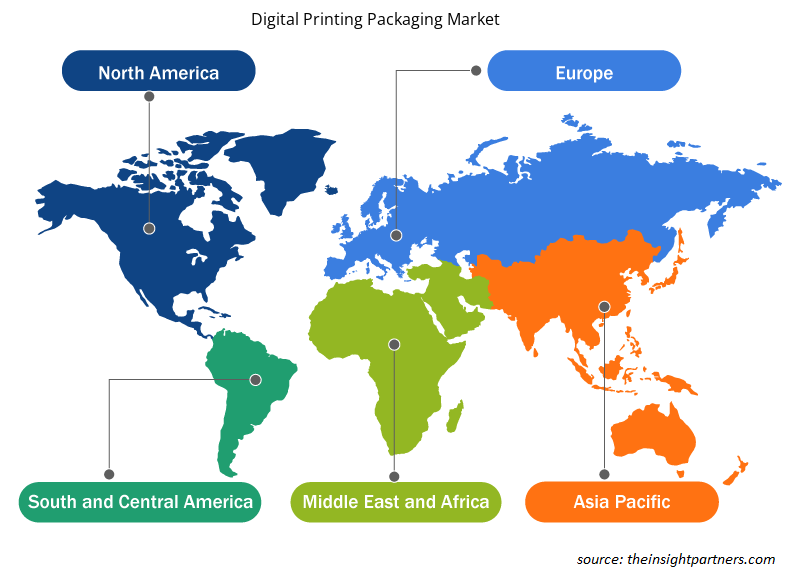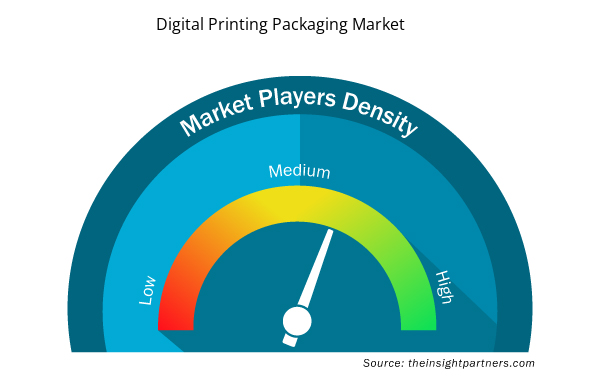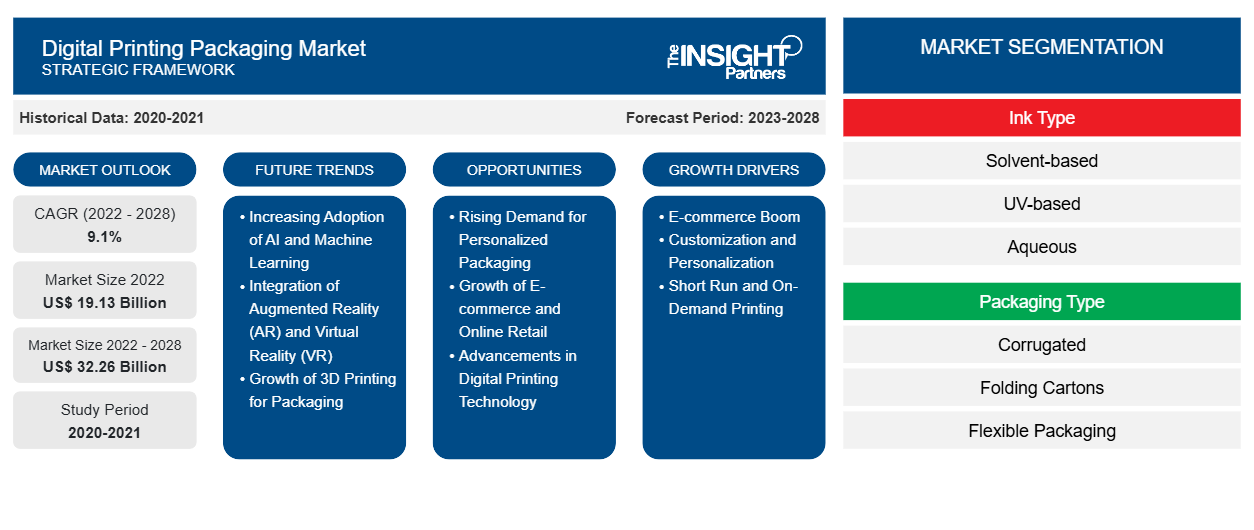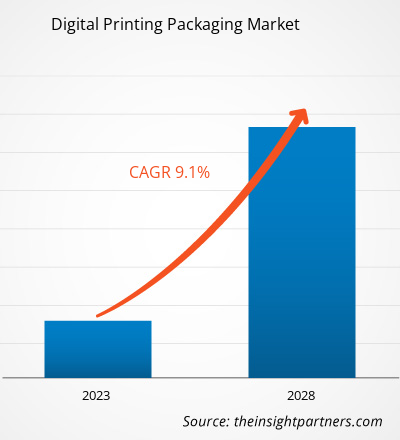预计到 2028 年,数字印刷包装市场规模将从 2022 年的 191.3113 亿美元增至 322.556 亿美元。预计 2022 年至 2028 年的复合年增长率为 9.1%。CAGR of 9.1% from 2022 to 2028.
由于对软包装和环保印刷的需求不断增长,数字印刷包装市场正在蓬勃发展。此外,印刷技术的快速发展扩大了软包装、瓦楞包装和折叠纸盒的范围。食品和饮料、药品、个人护理和化妆品等各种终端行业对有吸引力的数字印刷包装的需求不断增加。制造商正在投资包装,因为它可以吸引消费者并向消费者提供所有必要的信息。
2021 年,亚太地区占据全球数字印刷包装市场的最大份额,预计欧洲在预测期内的复合年增长率最快。食品包装需求的飙升以及对包装食品标签的高度重视,这些标签分享了产品的储存期限、成分和营养成分信息,是推动亚太地区数字印刷市场发展的主要原因。2021 年,东南亚国家联盟 (ASEAN) 的预制食品产品工作组 (PFPWG) 发布了食品接触材料 (FCM) 控制系统指南,包括东盟成员国的主动和智能包装材料。预计此类法规将推动亚太国家对数字印刷包装的需求。此外,根据世界银行集团成员国际金融公司 (IFC) 的数据,2015 年至 2020 年间,东南亚的电子商务规模增长了两倍,价值增长至 1050 亿美元。类似的趋势可能到2025年再增加三倍价值,即3090亿美元。因此,电子商务行业的增长有望推动数字印刷包装市场的扩张。
定制此报告以满足您的需求
您可以免费定制任何报告,包括本报告的部分内容、国家级分析、Excel 数据包,以及为初创企业和大学提供优惠和折扣
- 获取此报告的关键市场趋势。这个免费样品将包括数据分析,从市场趋势到估计和预测。
COVID-19 疫情对数字印刷包装市场的影响
COVID-19 疫情的爆发影响了全球几乎所有行业。在疫情初期,全球许多制造和开发机构被迫关闭运营。全球各州和国家政府实施了封锁措施,并确保了社交距离规范,以限制病毒的传播。此外,疫情爆发后随即爆发的金融危机导致制药和其他行业的商业推广大大推迟。结果,许多中小型公司的收入大幅下降。这些行业被视为各种技术提供商的支柱,自 2020 年 COVID-19 疫情爆发以来,它们一直在努力恢复。因此,由于疫情对供应链的破坏,市场参与者面临着诸多挑战。
市场洞察
数字印刷技术进步推动数字印刷包装市场
在包装、印刷和标签领域,技术发展迅速。数字印刷提供包装个性化、生产灵活性,并节省包装上市时间。由于各种设备改进和技术发展,品牌所有者和包装转换器更倾向于数字印刷。数字印刷的创新为公司提供了解决方案,将生产时间从数月缩短到数天。数字印刷包装的技术进步也有助于品牌推广和营销。包装上的直接印刷为产品提供了独特的外观。
数字印刷包装广泛应用于食品和饮料、药品、个人护理和化妆品等各个行业。由于喷墨和电子照相技术的重大发展,数字印刷正在成为一种经济高效且易于使用的印刷方法。数字印刷包装主要用于包装食品和饮料产品。对于食品和饮料以及其他消费品,数字印刷技术可提供高质量的包装,具有个性化、快速周转、减少浪费和即时修改包装设计等优点。在制药和大麻领域,制造商越来越多地转向数字印刷,以满足对本地化包装、法律要求的可变数据以及快速频繁转换的需求。设备的进步使得数字印刷各种包装材料和格式成为可能,包括食品包装纸、铝制饮料罐和金属化薄膜袋。因此,数字印刷包装领域的技术进步不断推动着市场增长。
基于墨水类型的见解
根据油墨类型,数字印刷包装市场分为溶剂型、UV 型、水性油墨和其他油墨。溶剂型油墨在 2021 年占据了最大的市场份额,而水性油墨预计在预测期内将实现最高的复合年增长率。溶剂型油墨由颜料和树脂(粘合剂)组成,后者是油墨的固体成分,溶剂是载体剂。在数字印刷过程中,溶剂型油墨被喷洒在基材上,导致溶剂蒸发,留下一层干燥的油墨。溶剂型油墨相对便宜。它在各种基材上具有广泛的数字印刷应用,例如箔、薄膜和硬质塑料,包括双向拉伸聚丙烯 (BOPP)、聚氯乙烯 (PVC)、聚对苯二甲酸乙二醇酯 (PET)、光面盒或纸板、金属和其他高密度聚乙烯材料。溶剂型油墨在 BOPP 和其他基材上具有耐久性,包括 PE、PET、铝箔和 PVC。全球许多数字印刷供应商都遵守包装印刷的国际和国内法规。这鼓励油墨制造商制定合规产品以满足客户需求。例如,2022 年 10 月,Kao Collins Inc. 推出了符合瑞士法令的五种颜色的溶剂型油墨——红色、黄色、蓝色、绿色和紫色。这些油墨是根据 EUPIA(全球印刷油墨协会)的印刷油墨指南配制和制造的。
基于包装类型的见解
根据包装类型,数字印刷包装市场细分为瓦楞纸、折叠纸盒、软包装、标签等。瓦楞纸部分在 2021 年占据了最大的市场份额,而软包装部分预计在预测期内将实现最高的复合年增长率。瓦楞纸板在两层之间包含拱门(称为凹槽),形成一个刚性柱。瓦楞纸箱的这种结构设计可抵抗压力并提供对突然温度变化的保护。通常,水基或水性油墨、油基和溶剂基油墨用于瓦楞包装上的数字印刷。由于电子商务网站的需求增加,对瓦楞纸包装的需求激增。对瓦楞纸包装的需求与电子商务销售有关,因为瓦楞纸包装是电子商务供应链的核心组成部分。
基于最终用途行业的见解
根据最终用途行业,数字印刷包装市场细分为食品和饮料、药品、个人护理和化妆品等。食品和饮料部门在 2020 年占据了最大的市场份额。由于制造商和品牌所有者越来越多地使用数字印刷标签和包装解决方案,数字印刷包装行业在过去几年中发生了巨大变化。如今,在数字印刷包装市场,有竞争力的价格已不足以选择产品,因为消费者正在寻求更好的产品体验。消费者更关心食品和饮料行业的增值和差异化,他们要求食品和饮料产品的安全性。全球消费者需要为他们消费的食品和饮料提供灵活的包装解决方案,以及不影响食品质量或安全的信息标签。因此,制造商正在采用溶剂型油墨进行食品和饮料行业的数字印刷包装。溶剂型油墨含有较少的有害化学物质。它们比紫外线、溶剂或液体墨粉油墨更安全、更环保。所有这些因素都改变了数字印刷包装模式。制造商正广泛关注数字和 3D 印刷包装制造的技术创新。
数字印刷包装市场的主要参与者包括惠普公司、施乐控股公司、Reel Appeal 有限公司、Mondi Plc、杜邦公司、Xeicon BV、Quantum Print and Packaging 有限公司、Weber Packaging Solutions 有限公司和 DS Smith Plc。这些公司专注于新产品的发布和地域扩张,以满足全球日益增长的消费者需求。它们在全球拥有广泛的业务,这使它们能够服务于大量客户,从而增加其市场份额。这些市场参与者高度重视新产品的发布和区域扩张,以增加其专业产品组合的产品范围。
数字印刷包装市场区域洞察
Insight Partners 的分析师已详尽解释了预测期内影响数字印刷包装市场的区域趋势和因素。本节还讨论了北美、欧洲、亚太地区、中东和非洲以及南美和中美洲的数字印刷包装市场细分和地理位置。

- 获取数字印刷包装市场的区域特定数据
数字印刷包装市场报告范围
| 报告属性 | 细节 |
|---|---|
| 2022 年市场规模 | 191.3亿美元 |
| 2028 年市场规模 | 322.6亿美元 |
| 全球复合年增长率(2022 - 2028) | 9.1% |
| 史料 | 2020-2021 |
| 预测期 | 2023-2028 |
| 涵盖的领域 | 按墨水类型
|
| 覆盖地区和国家 | 北美
|
| 市场领导者和主要公司简介 |
|
市场参与者密度:了解其对商业动态的影响
数字印刷包装市场正在快速增长,这得益于终端用户需求的不断增长,而这些需求又源于消费者偏好的不断变化、技术进步以及对产品优势的认识不断提高等因素。随着需求的增加,企业正在扩大其产品范围,进行创新以满足消费者的需求,并利用新兴趋势,从而进一步推动市场增长。
市场参与者密度是指在特定市场或行业内运营的企业或公司的分布情况。它表明在给定市场空间中,相对于其规模或总市场价值,有多少竞争对手(市场参与者)存在。
在数字印刷包装市场运营的主要公司有:
- 惠普公司
- 施乐控股公司
- 卷轴诉求有限公司
- 蒙迪公司
- 杜邦公司
免责声明:上面列出的公司没有按照任何特定顺序排列。

- 了解数字印刷包装市场的主要参与者概况
报告亮点
- 数字印刷包装市场的渐进式行业趋势,帮助企业制定有效的长期战略
- 发达国家和发展中国家数字印刷包装市场参与者采用的业务增长战略
- 2020 年至 2028 年市场定量分析
- 全球数字印刷包装需求预测
- 波特五力分析说明数字印刷包装市场中买家和供应商的效力
- 了解竞争市场状况的最新发展
- 市场趋势和展望,以及推动和制约数字印刷包装市场增长的因素
- 通过强调支撑商业利益的市场策略来协助决策过程
- 不同节点数字印刷包装市场规模
- 数字印刷包装行业详细概述和动态
- 各地区数码印刷包装市场规模及增长潜力巨大
- 历史分析(2 年)、基准年、预测(7 年)及复合年增长率
- PEST 和 SWOT 分析
- 市场规模价值/数量 - 全球、区域、国家
- 行业和竞争格局
- Excel 数据集


- Quantitative Structure-Activity Relationship (QSAR) Market
- Blood Collection Devices Market
- GMP Cytokines Market
- Unit Heater Market
- Vessel Monitoring System Market
- Sweet Potato Market
- Artificial Intelligence in Healthcare Diagnosis Market
- Space Situational Awareness (SSA) Market
- Influenza Vaccines Market
- Clear Aligners Market

Report Coverage
Revenue forecast, Company Analysis, Industry landscape, Growth factors, and Trends

Segment Covered
This text is related
to segments covered.

Regional Scope
North America, Europe, Asia Pacific, Middle East & Africa, South & Central America

Country Scope
This text is related
to country scope.
常见问题
Technological advancements in digital printing is driving the digital printing packaging market. Digital printing offers packaging personalization, production flexibility, and saves packaging time to market. Due to various equipment improvements and technological developments, brand owners and packaging converters are opting for digital printing.
Based on the packaging type, flexible packaging segment is projected to grow at the fastest CAGR over the forecast period. Digital printing on flexible packaging negates the need for labels and cardboard inserts. Therefore, this results in a significant reduction of waste, lower inventory requirements, and faster speed to market dynamics.
Asia Pacific accounted for the largest share of the global digital printing packaging market. China, Japan, and India are the major consumers in the digital printing packaging market due to the high demand for food and beverage products in these countries. The soaring demand for food packaging and high emphasis on packaged foods labels that share information about the product's storage life, composition, and nutritional content of products are the major reasons boosting the digital printing market in Asia Pacific.
Solvent-based inks are composed of pigment and resin (binder), which forms a solid component of the ink, and solvent as a carrier agent. The solvent-based ink is sprayed on a substrate during the digital printing process, which leads to the evaporation of the solvent, leaving behind a dry layer of ink. Solvent-based inks are relatively inexpensive. It has a wide range of digital print applications on various substrates.
The major players operating in the global digital printing packaging market are HP Inc, Xerox Holdings Corp, Reel Appeal Ltd, Mondi Plc, Dupont De Nemours Inc, Quad/Graphics Inc, Xeikon Bv, Quantum Print And Packaging Ltd, Weber Packaging Solutions Inc, and DS Smith Plc.
Rising demand for sustainable packaging is expected to provide potential market opportunities in the coming years in the digital printing packaging. Consumers across the globe are shifting toward convenient and sustainable packaging material.
Trends and growth analysis reports related to Chemicals and Materials : READ MORE..
The List of Companies - Digital Printing Packaging Market
- HP Inc
- Xerox Holdings Corp
- Reel Appeal Ltd
- Mondi Plc
- Dupont De Nemours Inc
- Quad/Graphics Inc
- Xeikon Bv
- Quantum Print and Packaging Ltd
- Weber Packaging Solutions Inc
- DS Smith Plc
The Insight Partners performs research in 4 major stages: Data Collection & Secondary Research, Primary Research, Data Analysis and Data Triangulation & Final Review.
- Data Collection and Secondary Research:
As a market research and consulting firm operating from a decade, we have published and advised several client across the globe. First step for any study will start with an assessment of currently available data and insights from existing reports. Further, historical and current market information is collected from Investor Presentations, Annual Reports, SEC Filings, etc., and other information related to company’s performance and market positioning are gathered from Paid Databases (Factiva, Hoovers, and Reuters) and various other publications available in public domain.
Several associations trade associates, technical forums, institutes, societies and organization are accessed to gain technical as well as market related insights through their publications such as research papers, blogs and press releases related to the studies are referred to get cues about the market. Further, white papers, journals, magazines, and other news articles published in last 3 years are scrutinized and analyzed to understand the current market trends.
- Primary Research:
The primarily interview analysis comprise of data obtained from industry participants interview and answers to survey questions gathered by in-house primary team.
For primary research, interviews are conducted with industry experts/CEOs/Marketing Managers/VPs/Subject Matter Experts from both demand and supply side to get a 360-degree view of the market. The primary team conducts several interviews based on the complexity of the markets to understand the various market trends and dynamics which makes research more credible and precise.
A typical research interview fulfils the following functions:
- Provides first-hand information on the market size, market trends, growth trends, competitive landscape, and outlook
- Validates and strengthens in-house secondary research findings
- Develops the analysis team’s expertise and market understanding
Primary research involves email interactions and telephone interviews for each market, category, segment, and sub-segment across geographies. The participants who typically take part in such a process include, but are not limited to:
- Industry participants: VPs, business development managers, market intelligence managers and national sales managers
- Outside experts: Valuation experts, research analysts and key opinion leaders specializing in the electronics and semiconductor industry.
Below is the breakup of our primary respondents by company, designation, and region:

Once we receive the confirmation from primary research sources or primary respondents, we finalize the base year market estimation and forecast the data as per the macroeconomic and microeconomic factors assessed during data collection.
- Data Analysis:
Once data is validated through both secondary as well as primary respondents, we finalize the market estimations by hypothesis formulation and factor analysis at regional and country level.
- Macro-Economic Factor Analysis:
We analyse macroeconomic indicators such the gross domestic product (GDP), increase in the demand for goods and services across industries, technological advancement, regional economic growth, governmental policies, the influence of COVID-19, PEST analysis, and other aspects. This analysis aids in setting benchmarks for various nations/regions and approximating market splits. Additionally, the general trend of the aforementioned components aid in determining the market's development possibilities.
- Country Level Data:
Various factors that are especially aligned to the country are taken into account to determine the market size for a certain area and country, including the presence of vendors, such as headquarters and offices, the country's GDP, demand patterns, and industry growth. To comprehend the market dynamics for the nation, a number of growth variables, inhibitors, application areas, and current market trends are researched. The aforementioned elements aid in determining the country's overall market's growth potential.
- Company Profile:
The “Table of Contents” is formulated by listing and analyzing more than 25 - 30 companies operating in the market ecosystem across geographies. However, we profile only 10 companies as a standard practice in our syndicate reports. These 10 companies comprise leading, emerging, and regional players. Nonetheless, our analysis is not restricted to the 10 listed companies, we also analyze other companies present in the market to develop a holistic view and understand the prevailing trends. The “Company Profiles” section in the report covers key facts, business description, products & services, financial information, SWOT analysis, and key developments. The financial information presented is extracted from the annual reports and official documents of the publicly listed companies. Upon collecting the information for the sections of respective companies, we verify them via various primary sources and then compile the data in respective company profiles. The company level information helps us in deriving the base number as well as in forecasting the market size.
- Developing Base Number:
Aggregation of sales statistics (2020-2022) and macro-economic factor, and other secondary and primary research insights are utilized to arrive at base number and related market shares for 2022. The data gaps are identified in this step and relevant market data is analyzed, collected from paid primary interviews or databases. On finalizing the base year market size, forecasts are developed on the basis of macro-economic, industry and market growth factors and company level analysis.
- Data Triangulation and Final Review:
The market findings and base year market size calculations are validated from supply as well as demand side. Demand side validations are based on macro-economic factor analysis and benchmarks for respective regions and countries. In case of supply side validations, revenues of major companies are estimated (in case not available) based on industry benchmark, approximate number of employees, product portfolio, and primary interviews revenues are gathered. Further revenue from target product/service segment is assessed to avoid overshooting of market statistics. In case of heavy deviations between supply and demand side values, all thes steps are repeated to achieve synchronization.
We follow an iterative model, wherein we share our research findings with Subject Matter Experts (SME’s) and Key Opinion Leaders (KOLs) until consensus view of the market is not formulated – this model negates any drastic deviation in the opinions of experts. Only validated and universally acceptable research findings are quoted in our reports.
We have important check points that we use to validate our research findings – which we call – data triangulation, where we validate the information, we generate from secondary sources with primary interviews and then we re-validate with our internal data bases and Subject matter experts. This comprehensive model enables us to deliver high quality, reliable data in shortest possible time.


 获取此报告的免费样本
获取此报告的免费样本